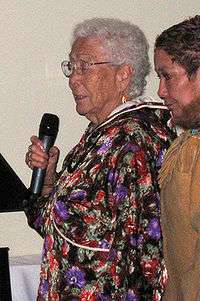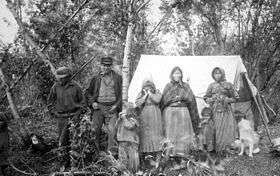Koyukon
The Koyukon are an Alaska Native Athabascan people of the Athabascan-speaking ethnolinguistic group. Their traditional territory is along the Koyukuk and Yukon rivers where they subsisted by hunting and trapping for thousands of years. Many Koyukon live in a similar manner today.
 Poldine Carlo, Koyukon author, 2007 | |
| Regions with significant populations | |
|---|---|
| United States (Alaska) | 2,300[1] |
| Languages | |
| English, Koyukon | |
| Religion | |
| Christianity, Animism | |
| Related ethnic groups | |
| Deg Hit'an, Gwich'in, other northern Athabaskan peoples | |
The Koyukon language belongs to a large family called Na-Dené or Athabascan, traditionally spoken by numerous groups of native people throughout northwestern North America. In addition, due to ancient migrations of related peoples, other Na-Dené languages, such as Navajo and Apachean varieties, are spoken in the American Southwest and in Mexico.
History
The first Europeans to enter Koyukon territory were Russians, who came up the Yukon River to Nulato in 1838. When they arrived they found that items such as iron pots, glass beads, cloth apparel, and tobacco had already reached the people through their trade with coastal Eskimos, who had long traded with Russians. An epidemic of smallpox had preceded them, causing high fatalities in the village. In subsequent years, European infectious diseases drastically reduced the Koyukon population, who had no immunity to them.
Relative isolation persisted along the Koyukuk until 1898, when the Yukon Gold Rush brought more than a thousand men to the river. They found little gold, and most left the following winter.[2]

Ethnobotany
They freeze the berries of Vaccinium vitis-idaea for winter use.[3]
Notable Koyukon
- Walter Harper, first man known to reach the summit of Denali (Mount McKinley), in June 1913
- Emil Notti, American engineer, indigenous activist and democratic politician
- Morris Thompson, businessman and leader
- Kathleen Carlo-Kendall, professional carver artist
- Poldine Carlo, writer and elder
References
- Alaska Native Language Center : Alaska Native Languages / Population and Speaker Statistics
- Shannon Michele McNeeley (2009), Seasons out of balance climate change impacts, vulnerability, and sustainable adaptation in Interior Alaska Archived 2016-08-24 at the Wayback Machine, Fairbanks, Alaska, August 2009
- Nelson, Richard K., 1983, Make Prayers to the Raven--A Koyukon View of the Northern Forest, Chicago. The University of Chicago Press, page 55
Further reading
- Hunn, E.S. & Williams, N.M.(Eds.). (1982). Resource Managers: North American and Australian Hunter-Gatherers. Westview Press: Colorado. Nelson, R.K. “A Conservation Ethic and Environment: The Koykon of Alaska” p. 211-228 Rohrlich, R & Baruch, E. (Ed.). (1984).
- Naciente, Esperanza. "Indigenous Lifestyles: Lessons for the Industrialized World." Fighting For Freedom Because A Better World Is Possible Eds. Edgey Wildchild and Esperanza Naciente. New York: Planting Seeds Press. 2006. 121-126.
- Nelson, Richard K. Make Prayers to the Raven: A Koyukon View of the Northern Forest. Chicago: University of Chicago Press, 1986. ISBN 0-226-57163-7
- Nelson, Richard K., Kathleen H. Mautner, and G. Ray Bane. Tracks in the Wildland: A Portrayal of Koyukon and Nunamiut Subsistence. [Fairbanks]: Anthropology and Historic Preservation, Cooperative Park Studies Unit, University of Alaska, Fairbanks, 1982.
- Peter, Adeline. Iñuksuk: Northern Koyukon, Gwich'in & Lower Tanana, 1800-1901. Fairbanks, AK: Alaska Native Knowledge Network, 2001. ISBN 1-877962-37-6
External links
![]()